So, you’re just going to have to trust us on this one because we have no photographic proof, but we did, indeed, hike and share a small lunch with the Queen Mother of Bhutan yesterday. It was truly a serendipitous once-in-a-lifetime experience for us. We thought our new friend and guide, Jigme, was going to achieve Nirvana right on the spot; he relived every moment of the hour-long visit on our 90 minute walk down the mountain afterwards. It was a thrilling and auspicious occasion that most Bhutanese never experience.
Let me start at the beginning, which was actually, according to JIgme, the day before yesterday. We had set out on the drive to our morning hike, and we came upon two gray langur monkeys in the road (of this much we have proof).
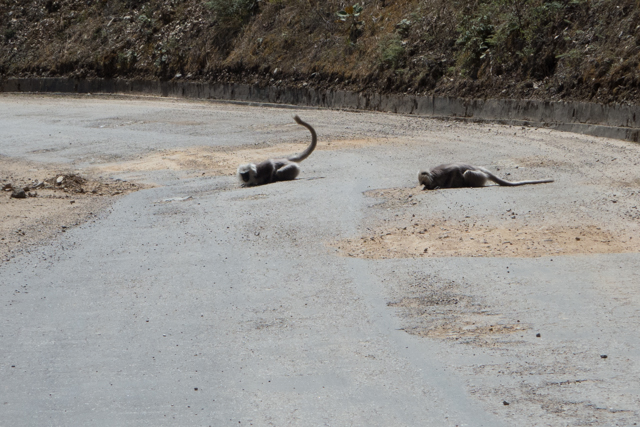
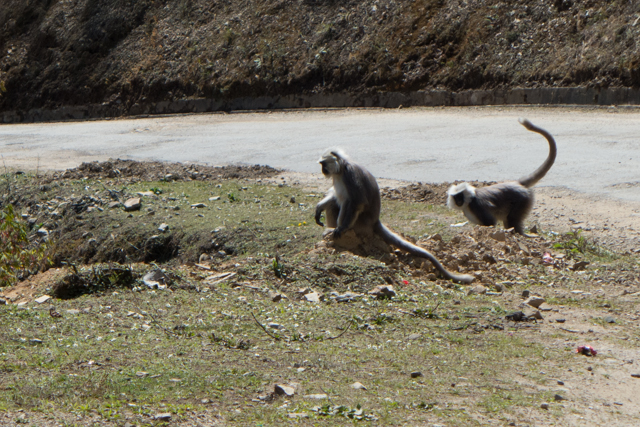
Then yesterday, after a morning hike through the Royal Botanical Park (incredible sighting of a yellow-billed blue magpie), we arrived at Dochula Pass.
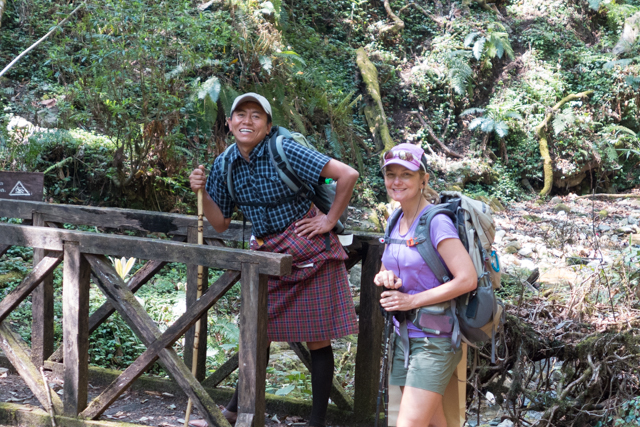

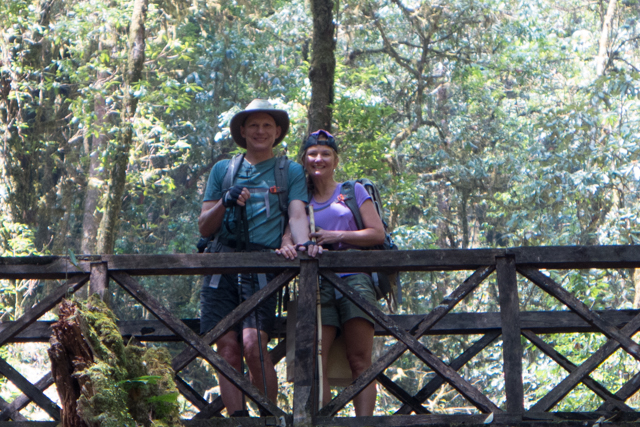
At lunch, Jigme told us the rather official looking fellow he chatted before coming in to the cafe was with the royal staff. Queen Mother Ashi Dorji Wangmo Wangchuck would soon be hiking the same trail we had planned for after lunch. I immediately assumed that meant we would need to find a different route to take. No, not at all, Jigme assured us, his excitement palpable. Our Queen Mothers, and all the royal family, are very open and accessible, and enjoy chatting with visitors when the occasion arises.
Yes, that’s plural Queen Mothers. The Fourth King, Jigme Singye Wangchuck (r. 1972 – 2006), married 4 (out of 5) sisters, descendants of Shabdrung Ngawang Namgyal, a Buddhist lama (spiritual leader) who unified Bhutan in the 17th century. Even though only one of them, the third youngest, is the birth mother of the current King, the King Father is said to treat all of them equally and with love. Polygamy is technically legal in Bhutan, but it is becoming less common because it is expensive to support multiple wives equally.
All four sisters were entitled to be called Queen while the Fourth King ruled, and now all are called Queen Mother (QM).
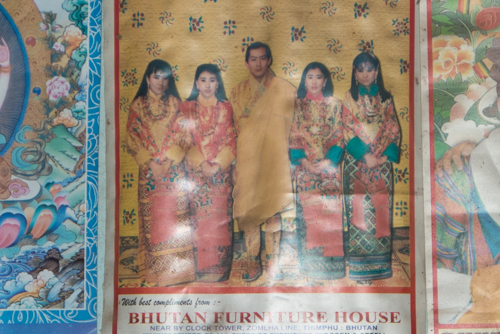
According to the literature, they married in a private ceremony in 1979. In response to growing public demand for celebrations in which the entire nation could participate, a public wedding ceremony was held in 1988 at the Punakha Dzong. By this time there were already 4 princes and 4 princesses.
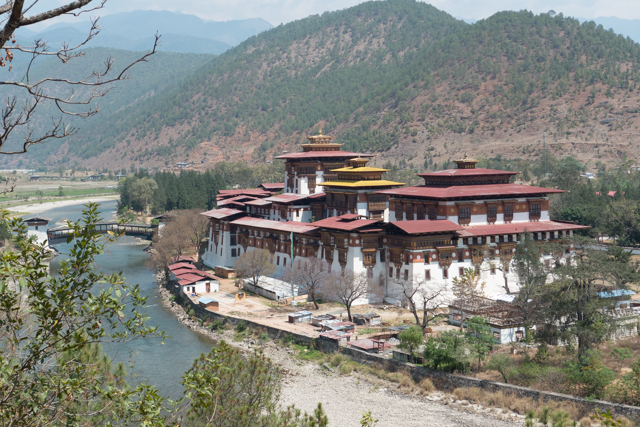
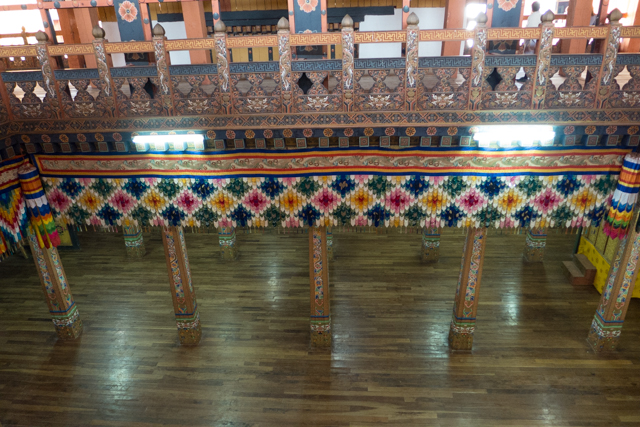
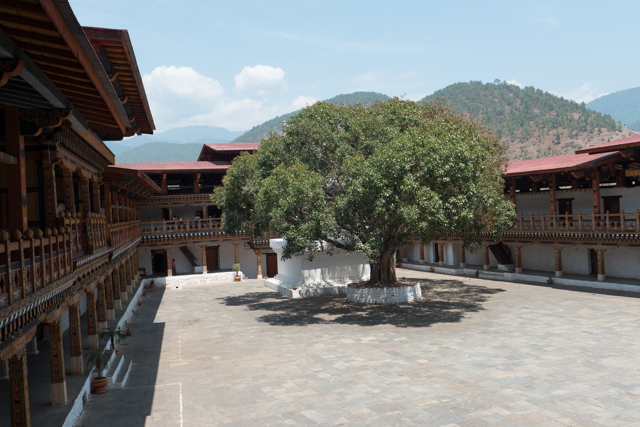
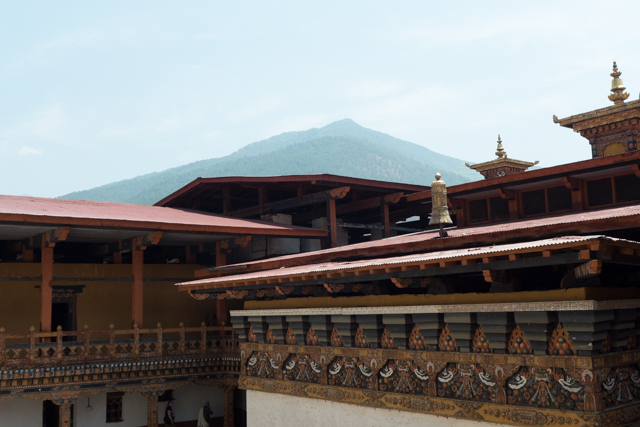
Ashi Dorji Wangmo is the first (and eldest) wife of the Fourth King. When we caught up with the QM after our lunch (she was hiking in a full-length kira afterall), she immediately struck up a conversation. Her entourage included a couple of guards, a monk, a couple of attendants, and Tashi, the wife of the current prime minister.
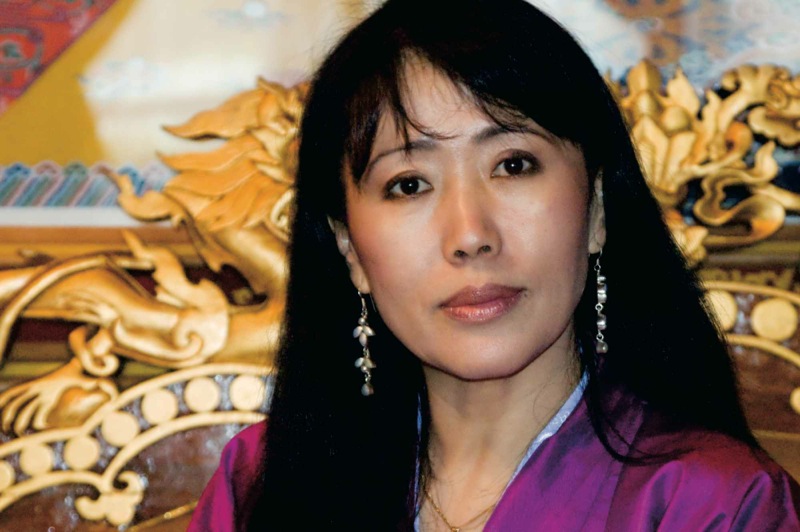
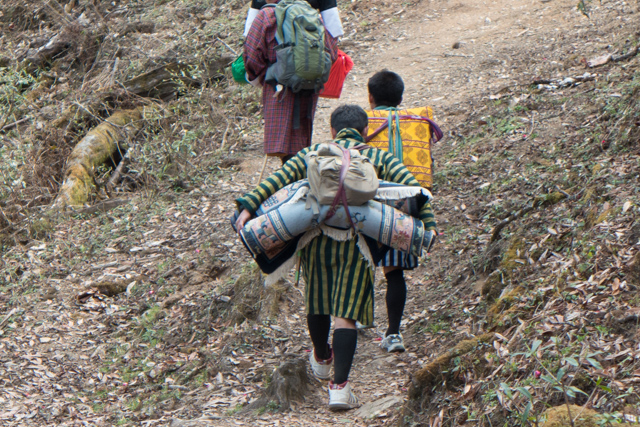
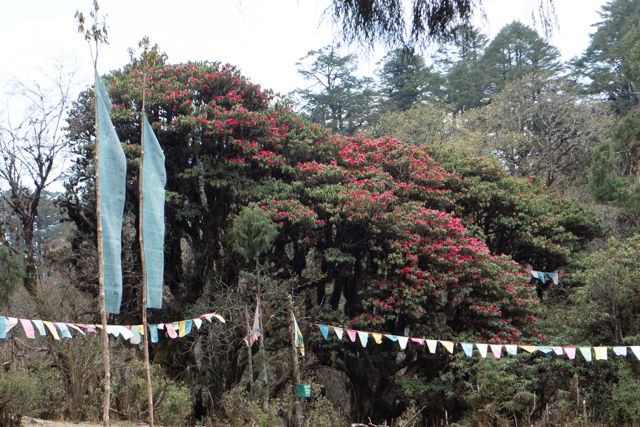
We exchanged the usual pleasantries. No, she hasn’t been to Texas, but has travelled quite a bit in the US, especially while her biological daughter attended Stanford and Harvard Law for her undergraduate and master’s programs respectively. NYC is her favorite city in the US. There are now 7 grandchildren in the family, with another boy and another girl expected soon. She speaks Dzongkha, Bengali, Nepali and HIndi; her English was flawless. It was obvious she is quite intelligent and well-traveled. She has written two books. Jigme loaned his copy of the second and it is well-written.
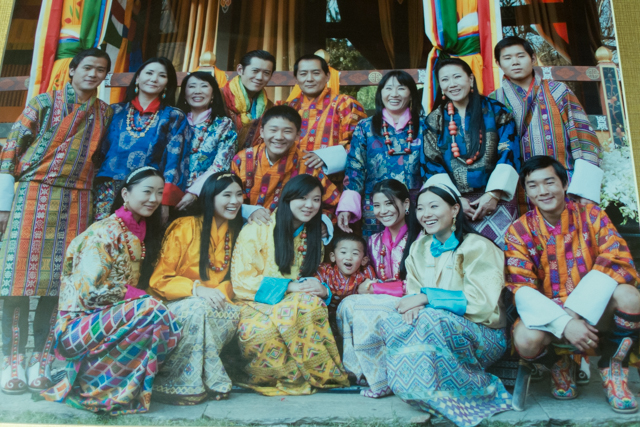
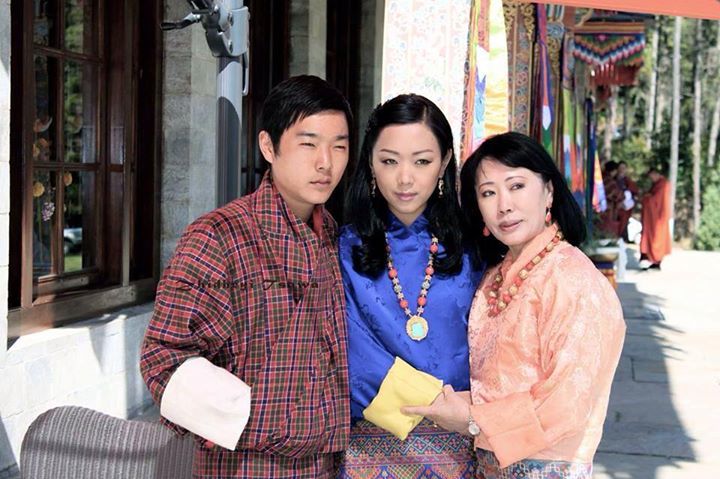
Besides answering our questions, she posed questions back, and gave us a bit of a pop quiz a couple of times. Luckily we had received good teaching from JIgme and she commented that we were well-informed. She diplomatically elaborated on the monk’s cautious answer to our question about reincarnation in light of the fact that many Bhutanese eat meat. In short, she said that Buddha was a pragmatist, encouraging a ‘middle-of-the-road’ approach, which would include eating meat for sustenance.
It was clear that she adores the Fourth King. (She is the only wife who lives in the same house as he does, though that didn’t come up in conversation.) She relayed to us that the king’s birth was prophesied (“I don’t know if you believe in prophecies, but here in Bhutan, we believe in prophecies”) to the exact year. The prediction was that a king would be born in the ‘year of the wood-sheep’. And so it was that Jigme Singye Wangchuck was born on November 11, 1955, the year of the wood-sheep.
She proudly recounted his bravery in the 2003 conflict (“also prophesied”) between Indian militants who had made Bhutan a base for terrorist attacks against India. The Indian rebels had established more than 30 guerilla camps in the dense jungles in southern Bhutan and despite more than 45 personal visits from the King over the prior 6 years (“at great personal risk of his life”), had refused to relocate or stop their attacks. The situation finally came to a head; despite being repeatedly warned, they wouldn’t leave. So Bhutan’s army moved against them, and the Fourth King led them into battle himself (“he isn’t want one to just sit back and push the red button”). The QM’s son (pictured above) accompanied him, delaying his first year at Oxford due to the conflict. Bhutan and Indian army forces quickly dispatched the opposition; the battle was over in a day and a half. Eleven Bhutanese soldiers had died and many more Indians.
The QM told us that she had come to the dilapidated Lungchusey Temple (elev. 11,700) before the war to pray for victory and safe deliverance for her King and the soldiers. The reason she had picked this temple was that it had been built in the 13th century by the master who prophesied the fourth king’s birth. She told us she made a bargain with Buddha that she would restore the temple herself if her prayers were answered; otherwise, she would not return to this sacred spot. This was the first time since we’ve been in the country that any story about praying to Buddha had included an ultimatum!
In the meantime, she had built a chorten (a structure containing Buddhist relics) on a hill above Dochula Pass “as a visible symbol of my fervent prayers to the deities to protect our country at this difficult time.” She also started plans for 108 chortens to be built, as symbols of her prayers for the safe return of the King and the soldiers. A hundred and eight is an auspicious number for Buddhists, representing the number of prayers that make up a complete cycle. There are 108 beads on a prayer bead strand for counting.
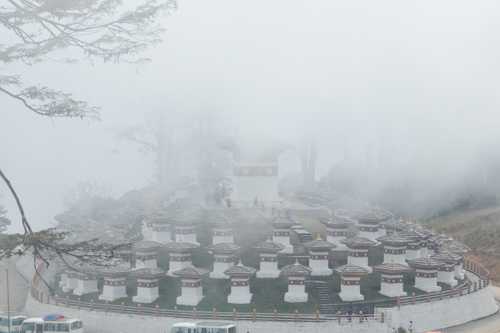
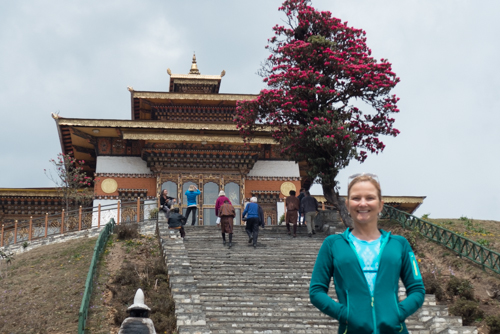
We asked the QM about her NGO and she was delighted to talk about The Tarayana Foundation. To date, Tarayana has built 700 quality homes for those in need in villages all over Bhutan. When you do that math, that’s .1% of the population number in Bhutan. The equivalent in America would be 314,000 homes. Tarayana has experienced great support from many Americans and is really making a difference in Bhutan.
When we reached the temple at the top of the mountain, the QM invited us in, with a wave of her hand indicating that it was okay that we were in our hiking shorts. We observed as she and the others did their salutations, gave their offerings and said their prayers, including the rolling of a pair of dice. The QM showed happiness at the resulting combination. We learned later that the QM had come to say prayers for the former King, who may be having some health problems.
The QM asked if we ate meat and then invited us to ‘share something in common’ in a small lunch. She worried that the dishes would be too spicy for us, but we’ve been loving the chili-flavored dishes. The meal started with the suedja – butter tea – and Tashi whispered that we shouldn’t feel obligated to drink it if we didn’t care for it. We noticed no one took more than a couple of sips.
The whole conversation was very normal, relaxed and open, almost as if meeting just anyone while hiking. Occasionally the QM would say something in Dzongkha to one of her guards. They would drop what they were doing to get her a glass of water or cut some blooms for her to give to the monks who greeted us (i.e., her) with great fanfare. We had her to ourselves as we didn’t encounter any other hikers.
The visit came to a bit of a weird and abrupt end however when the QM, with a nod of her head, indicated to the monk that the prayer (chanting) session should begin. With that she bowed her head and went to work. Our guide assured us that it wouldn’t be bad manners for us to leave; the prayers could go on for an hour or more.
The walk down the mountain was pretty amusing as Jigme, or we occasionally, would stop every few minutes to recount or reflect on the whole encounter. Jigme gave great weight to the gray langur monkey sighting the day before as an omen to our great fortune. Who are we to argue, it was a really fun, unique and special experience.

Wow!! Just wow!!
Wow, I was amused reading this post. Wish I could be there!
xoxoxo
WOW, that is absolutely amazing! You two (not to mention Jigme) we so fortunate to have such an encounter! The QM sounds like an amazingly well-rounded and humble individual as well, which is great to hear. Nothing worse than when being royalty goes to someone’s head.
I’ve already been somewhat obsessed with Bhutan for a while now but given everything I’ve just read you have really kicked my interest up a notch. I’m definitely going to have to start planning a trip over there soon 🙂
Soooo cool!! What an amazing encounter.